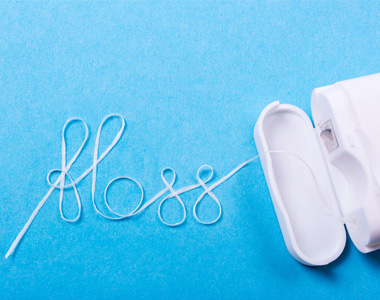
How to avoid the 4 most common flossing mistakes?
Category : Uncategorized
We all get that flossing is good for our oral health.
Research even shows that flossing helps reduce our risk of heart disease and other big hitters.
But did you know that flossing, if done incorrectly, could harm your oral health and even undermine your whole body health, too?
Here are 4 common flossing mistakes and some tips on how to floss correctly so you can avoid these costly errors that can undermine your health.
Flossing mistake #1: Zombie flossing
The first mistake most of us make while flossing is to just go through the routine without paying attention to what we’re doing or what the floss can tell us about the current state of our oral health.
We talk a lot about the importance of bringing awareness to our oral hygiene habits. We coined the term ‘conscious flossing‘ many years ago to describe this idea that we can bring more awareness to such a mundane habit as flossing our teeth.
The problems with flossing unconsciously (zombie flossing) are that we don’t gather the precious information that can be gained from ‘reading’ the used floss segments, and we stand to cause all sorts of damage by using an incorrect flossing technique.
So, let’s start by paying a little attention while we floss. Yes, we do sometimes floss while doing other things, like watching a movie. But we can still pay attention to what our flossing session tells us.
The solution to zombie flossing
Simply pay attention to any colors and smells that appear on the segment of floss that was used between two teeth.
Rather than ‘snap and run’ to the next pair of teeth, take a moment to ‘read the floss’ and see what’s going on between the two teeth you just flossed around. Do you have any color on the used floss segment? Does it smell? Did you have color/smell here the last time you flossed?
Paying just a little attention to what our floss tells us about any potential infection between two teeth (especially molars!) can be a very helpful first line of defense; we can use this information to take action and stop any gum infection from growing.
Flossing mistake #2: Using too little floss
Ok, we are a pretty thrifty family. We reuse plastic bags and tend to hoard glass bottles.
But when it comes to flossing, we each use at least 18″ per session. Here’s why…
Have you ever been doing your flossing routine and gotten to the last few teeth but have run out of floss? So you just ‘back up’ a few winds from your ‘used floss finger’ and finish up, right?
Well, doing so just may have transferred thug bugs from one infected gum pocket into another part of your mouth that’s not infected yet. Yeah, the bugs do move around the mouth pretty well on their own, but flossing is unfortunately an excellent way to ‘plant seeds’ of thug bugs into the gum pocket, where they can multiply and thrive.
It’s just not worth the risk.
Flossing mistake #3: Using vigorous, aggressive motions with floss pulled tightly
The two main reasons we floss are:
- to remove any food debris and plaque from between our teeth
- to disorganize any thug bugs and prevent them from colonizing in any gum pockets
While accomplishing the two objectives above, let’s remember that our gum tissue likes to be stimulated and massaged.
However, our gum tissue does not like to be tortured.
Snapping into the gum pocket quickly and banging on the gum tissue aggressively are sure ways to cause damage to our gums over time. Habitual torture to gums will cause the tissue to recoil and turn into gum recession.
The solution to using a vigorous flossing technique
Rather than taking an MMA (mixed martial arts) approach to flossing, try flossing with an aikido or tai chi mindset.
Allow the floss to be a bit slack while flossing rather than maintaining a super tightrope tension on the floss. Holding a slack floss will allow you to wrap the floss gently around the curve of each tooth, and this will do a much better job removing plaque and disrupting any bugs hanging around.
Once in the gum pocket and ‘hugging’ the curve of the tooth, gently but firmly slide the floss (with a soft level of tension on the string) down as far as the floss will reach (remember, no banging on the gum) and back up the tooth again. Do this 2-3 times. Then, move to the other ‘side’ of the contact between the two teeth and repeat.
Flossing mistake #4: Irregular flossing habits
Some experts speak out against flossing. Most of the experts in the ‘anti flossing’ camp reference the same research that suggests that flossing can drive bacteria from the mouth into the bloodstream and cause inflammation of heart tissue (called ‘infective endocarditis’).
Here’s the challenge: if we don’t floss regularly, populations of thug bugs grow and strengthen, which causes the gum tissue to become inflamed and bleed easily (gingivitis). It’s precisely this state of inflammation that allows the thug bugs to enter the bloodstream.
Regular flossing stops gingivitis in its tracks.
So, the problem with irregular flossing habits is we most likely are allowing bad bug populations to build, and this allows gum inflammation to develop. If we floss at that point, we are increasing our risk of driving bugs into our bloodstream.
The solution to irregular flossing
Simple enough, really: regular flossing.
While daily flossing helps, the research suggests that at least every other day is ‘regular’ enough to keep bad bug populations from colonizing the gum line.
When you consider just how effective flossing is in lowering the risk of disease throughout the whole body, it becomes clear that flossing is a simple yet important habit that we should incorporate into our daily routine.
How to maximize your benefit from flossing
Let’s sum this all up in a quick ‘To-Do’ list:
- Floss consciously. Check for color and smell after each contact.
- Use plenty of floss so you can use a clean segment for each contact.
- Floss your teeth using ‘tai chi’ hands rather than a ‘no mercy’ attitude.
- Allow the floss to wrap around each tooth to clean more effectively.
- Floss regularly, at least every other day.

 Review Us
Review Us  Review Us
Review Us